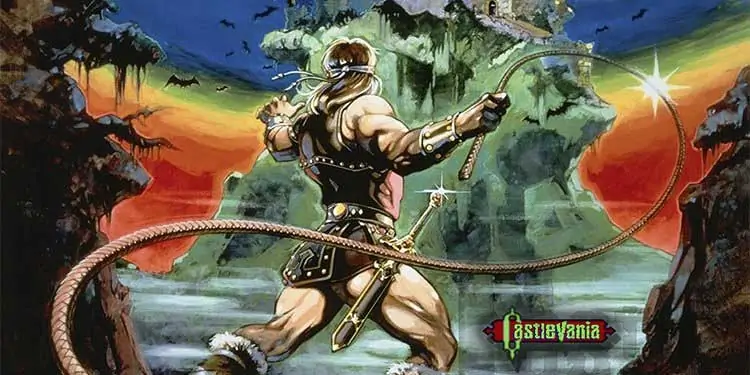Castlevania is a gothic action-adventure horror game series. It’s also a prolific vampire hunter media franchise by Konami.
Castlevania has 26 main series games, on top of spin-offs, collections, and crossovers we did not include for our sanity. Also, across the mainline titles, there’re various reboots or “retellings” of previous entries.
Its classic gameplay means 2D action side-scrolling. You often play as a member of the Belmont clan and advance through 2D environments. Along the way, you pick up weapons, defeat monsters, and beat the final boss in the Castle.
Simon’s Quest added an open-ended exploration plus a world map to revisit areas. It also added traders, weapon upgrades, towns, and other RPG elements.
The next big change happened in Symphony of the Night. It expanded the open-ended gameplay to lean the series into the Metroidvania genre.
Lastly, Castlevania 64 was the first Castlevania game in 3D. So, since 2003, Castlevania has remained a 3D action-adventure with an open-ended / Metroidvania exploration. It also greatly improved the combat mechanics.
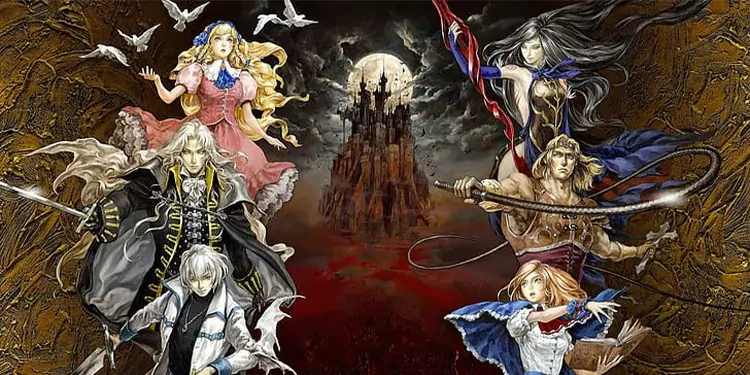
That said, there’re various alternative timelines, retellings, remakes, and reboots on top of the official main canon.
Castlevania Games in Order
Castlevania – 1986
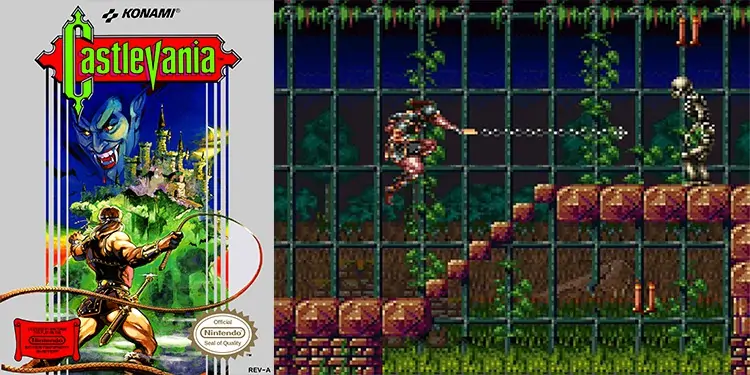
The first title debuted in Japan in 1986 and reached worldwide audiences in 1988. It became available from multiple consoles. These include MS-DOS PCs, Commodore 64, NES, Game Boy Advance, Wii Virtual Console, a3DS Virtual Console, PS4, Xbox One, and Nintendo Switch.
The game follows Simon Belmont. He inherited a mythical whip, brimming with holy power, from his father. He goes to Count Dracula’s Castle and slays the lord on a side-scrolling action-adventure.
Vampire Killer – 1986
The second entry debuted in Japan a few months after the original entry. It’s a parallel version of the original game, and it’s currently available in the Wii U Virtual Console.
Simon Belmont is the character on an alternative venture into Dracula’s Castle. The mechanics are different from the previous NES entry. Instead of linear levels, the game has labyrinth-like chapters.
Castlevania II: Simon’s Quest – 1987
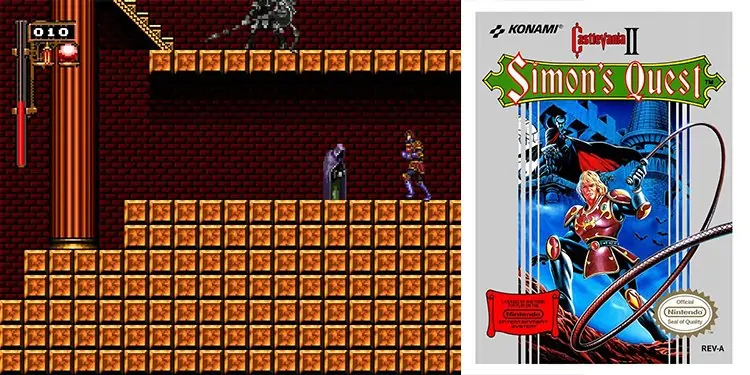
Simon’s Quest debuted in 1987 for the Famicom Disk System. In 1988, it debuted worldwide for the NES.
It follows the first installment and continues the Simon Belmont storyline. He’s on a journey to stop a cursor Dracula placed on him during their final fight. He must return to the Castle’s ruins to save himself.
The game introduced several changes to the franchise. There’re now towns and villagers with items and clues. There’s also a non-linear design, a world map, in-game currency, and weapon upgrades.
Haunted Castle – 1987
Haunted Castle is the next side-scrolling adventure. It debuted as an arcade title in 1987, but it became available for PlayStation 2 and PlayStation 4.
It worked as a port of the original Castlevania title, but it had a few changes. For example, Simon Belmont’s journey against Dracula is also about saving his wife, Selena. Also, his main weapon is a spiked club, the Morning Star. Belmont can upgrade his weapon by collecting special items and collecting sub-weapons as well.
Castlevania: The Adventure – 1989
The next platformer debuted for Game Boy in 1989. Later on, it launched for Game Boy Color as well.
The story happens a Century before Castlevania. The playable character is Christopher Belmont, a Simon Belmont ancestor. He goes on a quest to defeat the vampire lord. Unlike previous games, there’re no sub-weapons, but there’re weapon upgrades.
Castlevania III: Dracula’s Curse – 1989
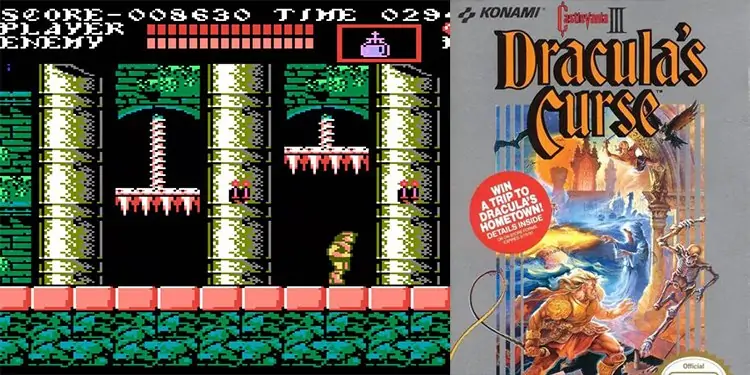
The next entry debuted for the NES in 1989 in Japan and 1990 worldwide. Later, It also premiered for the Wii Virtual Console, Nintendo 3DS Virtual Console, and Wii U Virtual Console.
It’s a prequel to The Adventure, centuries before the original title. The protagonist is Trevor C. Belmont, also the main character of the Netflix series.
As a novelty, the player can choose between two stages at several points in the game, which leads to various endings. However, it abandons RPG and open-ended elements for a classic side-scrolling experience.
Castlevania II: Belmont’s Revenge – 1991
Belmont’s Revenge debuted for Game Boy in 1991 and Game Boy Color in 2000.
Its plot is 15 years after The Adventure. Dracula returns and kidnaps Christopher’s son Soleil and turns him into a demon. The new devil helps Dracula regain his body and retake his Castle. The setting opens up similar gameplay with the novelty as holy water and axes as sub-weapons.
Super Castlevania IV – 1991
Super Castlevania IV debuted in 1991 for the SNES. There have been multiple re-releases since its original debut. The new console allowed an expanded control, 16-bit graphics, a new soundtrack, and higher levels. Still, it follows previous mechanics.
You play as Simon Belmont in 1691, Transylvania. He’s on a new journey to defeat Dracula. The gameplay comes through side-scrolling, but the player must start over if they lose all lives. Also, the whip can attack in several directions, and there’re ways to upgrade the weapon. Lastly, there’re secondary weapons and other collectibles.
Castlevania Chronicles – 1993
Chronicles debuted for the X68000 PC system in 1993. Later on, it debuted for PlayStation 1.
It’s a remake of the original title that adds various features. For instance, it had a new engine that improved graphics and performance. It also had redesigned levels, new stages, new special items, and a new healing item.
Castlevania: Rondo of Blood – 1993
The next entry debuted for the PC Engine Super CD-ROM System in 1993. It introduces Richter Belmont on a journey to save the one he loves, Annette. Dracula abducted her, and so he must enter the Castle for a new platforming adventure.
The gameplay happens across four alternative routes to rescue Annette and face Dracula. Richer can use a whip and six sub-weapons. Then, depending on the paths Ritcher takes, players experience different environments and monsters. Lastly, Richer can save four kidnapped maidens, and one of them becomes a playable character.
Castlevania: Bloodlines – 1994
Bloodlines debuted in 1994 for the Sega Genesis. It’s a parallel story that introduces a new era and new characters. During World War I, the vampire Elizabeth Bartley plans a sacrificial war to return Dracula, his uncle, back to life.
Players control two new vampire hunters on a fast-paced action platformer. Each character has special abilities and controls, and they can attack enemies diagonally.
Castlevania: Dracula X – 1995
Dracula X debuted in 1995 for the Super Nintendo. Later on, it debuted for the Nintendo 3DS Virtual Console.
It’s a re-telling of the Rondo of Blood storyline with a different art style, redesigned levels, and new mechanics. For example, there’re only two alternate levels instead of four, and there’re no extra playable characters.
Castlevania: Symphony of the Night – 1997
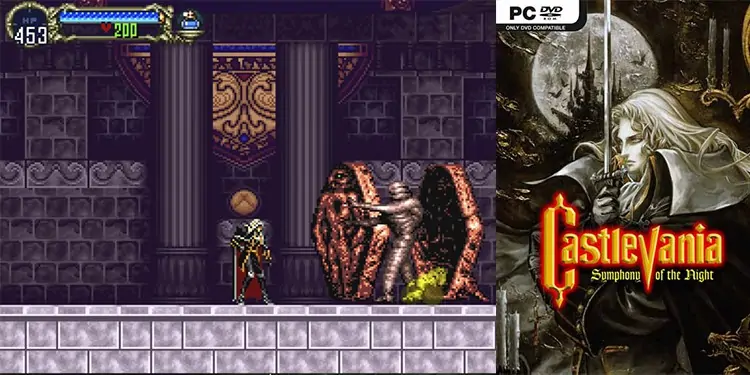
Symphony of the Night debuted for PlayStation in 1997 as a direct sequel to Rondo of Blood. Even though the title sold poorly initially, its cult following grew over time. Nowadays, it has widespread acclaim, and it’s considered one of the best games of all time. Its gameplay, atmosphere, graphics, and mechanics pioneered many action-adventure games to come.
The game re-introduces non-linear exploration and leans towards a Metroidvania design. It also adds RPG elements like towns, traders, weapon upgrades, a world map, and character progression systems.
The protagonist is Alucard. he explores Dracula’s Castle, a large interconnected area. Visuals come through a 2D side-scrolling, and the goal is defeating the entity Shaft, who’s controlling Richter Belmont. Players can only see Shaft after finding a particular item.
However, once you defeat Shaft, the game becomes an upside-down version of the Castle, with new enemies and bosses. There, Alucard has to find five special items to defeat Dracula in a final fight. Lastly, as you’d expect from a Metroidvania, many Castle areas are inaccessible until players find collectibles or learn abilities.
Castlevania Legends – 1997
Legends debuted for Game Boy in 1997 (Japan) and 1998 (worldwide). It’s a non-canon prequel to the whole Castlevania series.
The story follows Sonia Belmont fighting against the first Count Dracula incarnation. Gameplay comes through the classical side-scrolling mechanics, a whisp, collectibles, and special abilities. Moreover, the game adds difficulty levels and save states.
Castlevania 64 – 1999
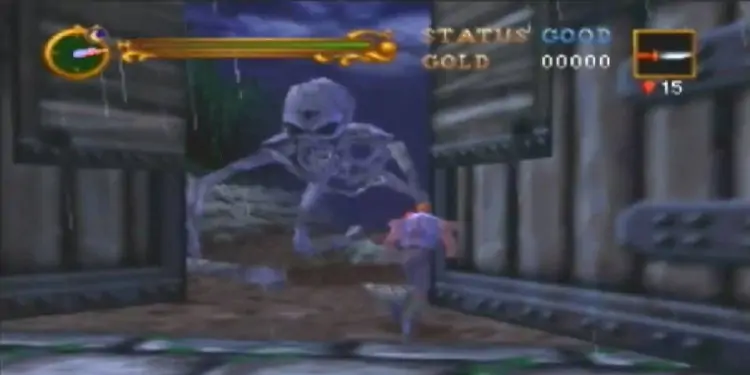
Castlevania 64 (also known simply as Castlevania) is a 1999 title for the Nintendo 64. It’s the first Castlevania in 3D. Thus it added many changes to the series. Also, it’s a parallel story.
The story follows various playable protagonists. Carrie Fernandez, a young orphan with powers, or Reinhart Schneider, heir of the Belmont clan. They are on a quest to stop Dracula’s return.
As a 3D title, the gameplay became a 3D action-adventure platformer. Combat also became more complex and included a lock-on system. There’re also long, medium, and short-range attacks, on top of various sub-weapons, weapon upgrades, currency, and vendors. Lastly, the game keeps Metroidvania elements plus a night & day cycle NPCs, and collectible items follow.
Castlevania: Legacy of Darkness – 1999
Legacy of Darkness debuted for Nintendo 64 in 1999. It’s a prequel expansion for Castlevania 64. Also, it packs a remake of the original game with new villains and alternate levels.
The protagonist is Cornell, a man who can turn into a werewolf. He’s traveling to Dracula’s Castle to save his sister, Ada, selected as a sacrifice to resurrect the vampire lord. The gameplay is similar to the previous game, with extra platforming and turning into a werewolf. Lastly, it has survival horror elements like caged fights in the darkness.
Castlevania: Circle of the Moon – 2001
Circle of the Moon debuted in 2001 for Game Boy Advance. It’s a canon adventure retelling the Centuries-old conflict between the Belmont clan and Dracula.
This is a 2D action platformer similar to previous titles. However, the lead character is Nathan Graves, searching for his kidnapped mentor in the Castle.
Castlevania: Harmony of Dissonance – 2002
The next entry debuted in 2002 for Game Boy Advance. It’s also available (as part of a collection) for Nintendo Switch, PS4, Xbox One, and Windows.
It’s a direct sequel to Simon’s Quest, fifty years after Castlevania II. The protagonist is Juste Belmont, Simon’s grandson. He’s on a quest to rescue a childhood friend in Dracula’s Castle. So, the gameplay stays similar to previous titles, with a 2D perspective and a Metroidvania design.
Castlevania: Aria of Sorrow – 2003
Aria of Sorrow debuted in 2003 for Game Boy Advance. It’s a canon story nearly at the end of the Castlevania timeline. In the year 2035, Dracula has been sealed since 1999. That means the setting is futuristic rather than being a medieval game.
The game follows Soma Cruz, a teenager with occult powers and a potential vessel for Dracula’s reincarnation. The setting opens up a side-scrolling adventure with RPG elements, Metroidvania features, and the “Tactical Soul” system. The latter allows players to absorb unique enemy souls to get additional abilities.
Castlevania: Lament of Innocence – 2003
Lament of Innocence debuted in 2003 for PlayStation 2. It’s the third entry in the series with 3D graphics and the first title in the canon timeline.
The year is 1094, and Leon Belmont is searching a vampire castle for his kidnapped betrothed. The gameplay is similar to Symphony of the Night. However, the title includes puzzles, concealed rooms and items, and many boss fights. In particular, the game has a central hub where the player can access one of the five main areas available.
Castlevania: Dawn of Sorrow – 2005
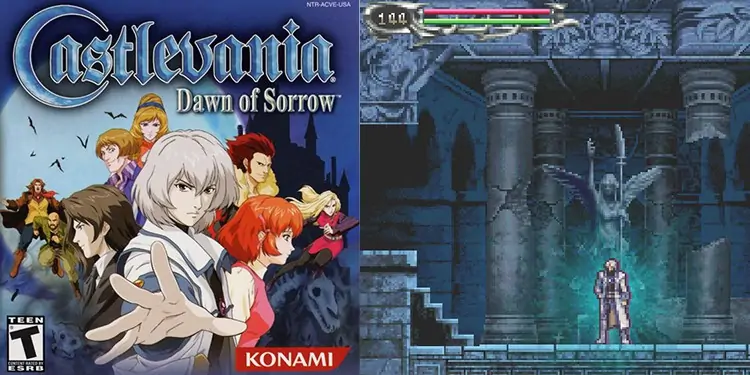
Dawn of Sorrow debuted in 2005 for the Nintendo DS. It continues the Aria of Sorrow storyline and adds a couple of mechanics to expand its gameplay.
For instance, it keeps the “Tactical Soul” system and introduces a “Magic Seal” system. Players have to use the DS stylus to write a pattern on the tactile screen and defeat enemies. Lastly, the title has an anime character design and a multiplayer mode.
Castlevania: Curse of Darkness – 2005
Curse of Darkness debuted in 2005 for PlayStation 2 and Xbox. It’s another 3D action-adventure title following the Symphony of the Night formula.
The story follows Hector in the year 1579, three years after Castlevania III. Hector is a Devil Forgemaster who worked for Dracula but ultimately betrayed him. His new mission is revenge against those who hurt his fiancee.
The gameplay differs from previous titles because of the playable character. Hector can use various ranged and melee weapons or unlock special abilities like summoning minions. However, after finishing the game, players can also unlock Trevor Belmont for a second playthrough.
Castlevania: Portrait of Ruin – 2006
The next entry debuted in 2006 for Nintendo DS. It’s the first game in the series with a co-op multiplayer mode and English voice-overs aside from the Japanese voices.
This game continues Bloodlines, and the setting is 1944, during WWII. It introduces various protagonists and antagonists and expands the overall lore of the series. Also, the game features alternate paths and two distinct endings.
Still, the gameplay remains similar to before. You play as Jonathan and Charlotte, and they can combine their abilities for powerful attacks, traverse, and puzzle-solving. Their goal is preventing yet another Dracula resurrection, as well as defeating vampire lord Brauner.
Castlevania: The Dracula X Chronicles – 2007
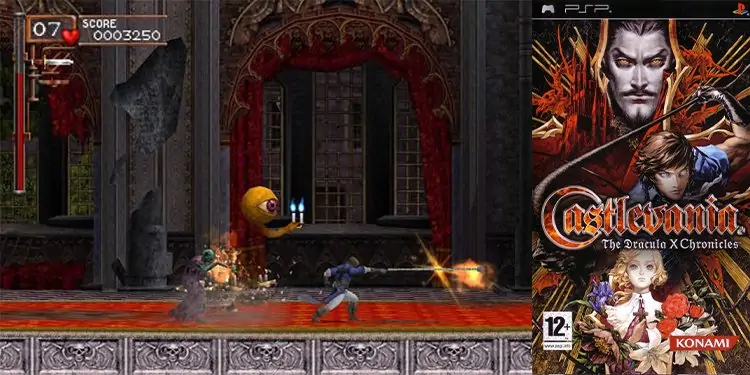
The Dracula X Chronicles debuted for the PlayStation Portable in 2007. It’s a remake of Rondo of Blood with 2.5D graphics. Also, it packs a remastered port of Symphony of the Night.
For Rondo of Blood, the X version doesn’t change much other than the graphics. However, minor features improve the challenge by adding platforming and puzzle sections.
Castlevania: Order of Ecclesia – 2008
Order of Ecclesia debuted for Nintendo DS in 2008. It introduces Shanoa, a member of an organization that seeks to defeat Dracula after the Belmont clan was defeated.
The game has a 2D action-adventure gameplay, with RPG and adventure elements. For example, the character can equip and cast spells, equip Glyph Symbols for special powers, and gain Magic Points to become stronger.
Castlevania: The Adventure ReBirth – 2009
The Adventure ReBirth debuted in 2009 for the WiiWare. It’s a remake of 1989’s Castlevania: The Adventure.
Castlevania: Lords of Shadow – 2010
Lords of Shadow debuted in 2010 for PlayStation 3 and Xbox 360. A PC version was released in 2013.
This is a reboot of the series. It focuses on Gabriel Belmont on a quest to defeat the Lord of Shadows and resurrect his life. The gameplay comes in 3D and delivers combo-style combat with various weapons, skills, and weapon upgrades.
Castlevania: Lords of Shadow – Mirror of Fate – 2013
In the reboot timeline, the next video game debuted in 2013 for PS3, Nintendo 3DS, Xbox 360, and Windows (2014).
Gabriel Belmont returns, but also Trevor and Alucard as playable characters. Then, this is a side-scrolling action-adventure title, as it returns to the classical Castlevania mechanics. The one difference is how each character has its own segment in the game.
Castlevania: Lords of Shadow 2 – 2014
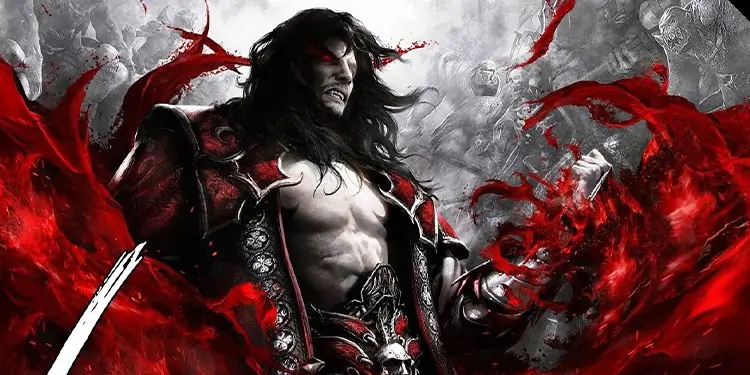
Lords of Shadow 2 is the latest entry in the franchise. It’s a sequel to Lords of Shadow, and it debuted in 2014 for PS3, Xbox 360, and Windows PC.
The story happens in medieval and modern settings. It follows Dracula on a quest to defeat Satan. This time around, players control Dracula in an open world. He can use multiple powers and weapons to defeat his enemies.
All Castlevania Games in Chronological Order
- Castlevania – 1986
- Vampire Killer – 1986
- Castlevania II: Simon’s Quest – 1987
- Haunted Castle – 1987
- Castlevania: The Adventure – 1889
- Castlevania III: Dracula’s Curse – 1989
- Castlevania II: Belmont’s Revenge – 1991
- Super Castlevania IV – 1991
- Castlevania Chronicles – 1993
- Castlevania: Rondo of Blood – 1993
- Castlevania: Bloodlines – 1994
- Castlevania: Dracula X – 1995
- Castlevalia: Symphony of the Night – 1997
- Castlevania Legends – 1997
- Castlevania 64 – 1999
- Castlevania: Legacy of Darkness – 1999
- Castlevania: Circle of the Moon – 2001
- Castlevania: Harmony of Dissonance – 2002
- Castlevania: Aria of Sorrow – 2003
- Castlevania: Lament of Innocence – 2003
- Castlevania: Dawn of Sorrow – 2005
- Castlevania: Curse of Darkness – 2005
- Castlevania: Portrait of Ruin – 2006
- Castlevania: The Dracula X Chronicles – 2007
- Castlevania: Order of Ecclesia – 2008
- Castlevania: The Adventure ReBirth – 2009
- Castlevania: Lords of Shadow – 2010
- Castlevania: Lords of Shadow – Mirror of Fate – 2013
- Castlevania: Lords of Shadow 2 – 2014

